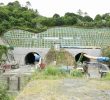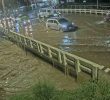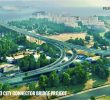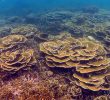DAVAO CITY – City officials will deliberate this week on what to do with hundreds of trees lining the drainage canal area in Dacudao Avenue which they said is damaging the structure of the canal.
The city’s Task Force Drainage head Yusof Jimlani announced during Monday’s Kapehan sa SM media forum that he will call in some 20 of the task force members for a consultative meeting on Wednesday.
Jimlani clarified that contrary to earlier news reports and criticisms in social media, there is still no final decision by the task force whether to cut off the trees to save the structure of the canal.
“We have not cut a single tree, yet they are already saying we had cut them off,” Jimlani fumed.
Jimlani has extended an open invitation to the public especially environment groups to attend the consultative meeting to hear out all sides.
The City Engineering Office (CEO) released a report last July to the task force recommending the cutting of trees along the canal as part of their rehabilitation of the canal.
The task force showed photos that the tree roots have protruded and have caused cracks in some of the riprap and canal structure.
Jimlani said the trees that were planted were hardwood such as mahogany and gemelina.
But the City Environment and Natural Resources Office (Cenro) objected to the proposal saying the trees can mitigate flooding.
A technical report from Cenro-Natural Resources Operation Division said that one mature tree can intercept more than 4,000 gallons of water per year.
The report also showed that the structural problems are not caused solely by the protruding of tree roots.
“Although some of the root system of the trees were protruding, it was not the leading reason why the riprap collapsed in some areas of the main drain. It was observed that those areas that have no trees were the areas where failure of structure is prevalent,” the Cenro report said.
“Though it is true that the root system will compromise some edifice, in the case of the Dacudao Main Drain, it is not the main reason of failure of structure. Rather, it was due to the dilapidation and poor quality of work,” the report said.
Cenro recommended that the trees can be spared from cutting down by redesigning the canal to integrate existing trees in its rehabilitation plan.
Jimlani said the meeting would try to draw views from various bodies including representatives from the CEO, Cenro, City Agriculture Office, Department of Public Works and Highways.
“First thing I would ask, what kind of trees should have been planted there? Do we need to cut down trees, or do we do pruning or transferring?” he said.
Jimlani said the trees planted along Dacudao are the “wrong trees” as mahogany is a hardwood that would grow three meters in diameter.
He said that initially the City Legal Office came out with an opinion that the cutting of trees is recommended for public safety.
But he added that the final decision still rests on City Mayor Rodrigo Duterte based on recommendations that the task force would make from their consultations.
Mayor Duterte also called for a “compromise” from both sides of the government bodies on this matter during his public service program last Sunday. He also find the cutting of trees not necessary because of the “aesthetic value” of the trees.
The environment group Interface Development Interventions (Idis) said the local officials should not blame the trees for the problems in the canal structure.
Idis advocacy officer Chinkie Pelino said, “we are aware of the need to maintain the city’s drainage canals but it should not be made at the expense of cutting mature trees because they are a very important resource that a city needs to mitigate the negative effects of climate change on an urban landscape.” (Tyrone A. Velez/davaotoday.com)










